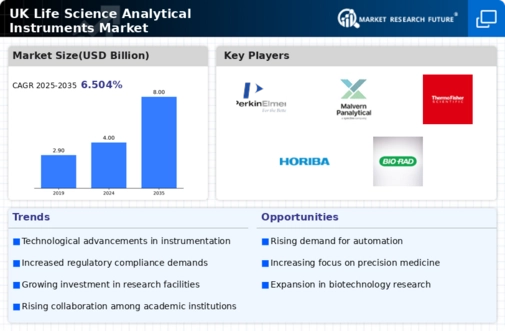The life science-analytical-instruments market is characterized by a dynamic competitive landscape, driven by innovation, technological advancements, and increasing demand for precision in research and diagnostics. Key players such as Thermo Fisher Scientific (US), Agilent Technologies (US), and Waters Corporation (US) are at the forefront, each adopting distinct strategies to enhance their market positioning. Thermo Fisher Scientific (US) emphasizes innovation through continuous investment in R&D, focusing on developing cutting-edge analytical instruments that cater to diverse applications in life sciences. Meanwhile, Agilent Technologies (US) has been actively pursuing strategic partnerships to expand its product offerings and enhance its service capabilities, thereby strengthening its competitive edge. Waters Corporation (US) appears to be concentrating on digital transformation initiatives, integrating advanced data analytics into its instruments to provide enhanced user experiences and operational efficiencies.
The market structure is moderately fragmented, with a mix of established players and emerging companies vying for market share. Key business tactics include localizing manufacturing to reduce costs and optimize supply chains, which is particularly relevant in the current economic climate. The collective influence of these major players shapes the competitive dynamics, as they leverage their strengths to navigate challenges and capitalize on growth opportunities.
In October 2025, Thermo Fisher Scientific (US) announced the launch of a new line of mass spectrometry systems designed to enhance the accuracy and speed of drug discovery processes. This strategic move is likely to solidify its position as a leader in the analytical instruments sector, addressing the growing demand for rapid and reliable analytical solutions in pharmaceutical research. The introduction of these advanced systems may also attract new customers, further expanding Thermo Fisher's market reach.
In September 2025, Agilent Technologies (US) entered into a collaboration with a leading biotechnology firm to develop integrated solutions for genomic analysis. This partnership is indicative of Agilent's strategy to enhance its capabilities in high-throughput screening and genomic research, potentially positioning the company as a key player in the rapidly evolving field of personalized medicine. Such collaborations may also facilitate access to new technologies and markets, thereby driving future growth.
In August 2025, Waters Corporation (US) unveiled a new software platform that integrates artificial intelligence (AI) into its analytical instruments, aimed at improving data interpretation and operational efficiency. This development reflects a broader trend towards AI integration within the industry, suggesting that Waters is keen to leverage technology to enhance its product offerings. The ability to provide AI-driven insights could differentiate Waters from competitors, appealing to customers seeking advanced analytical capabilities.
As of November 2025, the competitive trends in the life science-analytical-instruments market are increasingly defined by digitalization, sustainability, and the integration of AI technologies. Strategic alliances are becoming more prevalent, as companies recognize the value of collaboration in driving innovation and expanding their market presence. Looking ahead, competitive differentiation is likely to evolve, with a shift from price-based competition towards a focus on innovation, technological advancements, and supply chain reliability. This transition may ultimately reshape the landscape, as companies that prioritize these elements are better positioned to thrive in an increasingly complex market.
















Leave a Comment